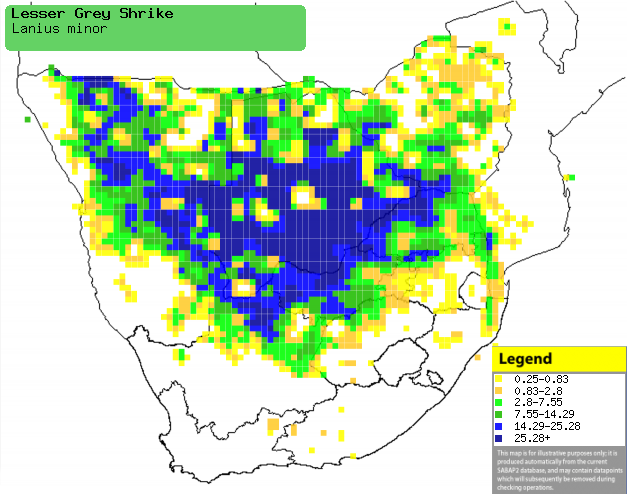|
Lanius minor (Lesser grey
shrike)
Gryslaksman [Afrikaans]; Nankuwo (generic term for
shrike) [Kwangali]; Temeli (also applied to Red-backed shrike and Common
fiscal) [South Sotho]; Juka, Rhiyani (these terms also applied to Common fiscal)
[Tsonga]; Kleine klapekster [Dutch]; Pie-grièche à poitrine rose [French];
Schwarzstirnwürger [German]; Picanço-pequeno [Portuguese]
Life
> Eukaryotes >
Opisthokonta
> Metazoa (animals) >
Bilateria >
Deuterostomia > Chordata >
Craniata > Vertebrata (vertebrates) > Gnathostomata (jawed
vertebrates) > Teleostomi (teleost fish) > Osteichthyes (bony fish) > Class:
Sarcopterygii (lobe-finned
fish) > Stegocephalia (terrestrial
vertebrates) > Tetrapoda
(four-legged vertebrates) > Reptiliomorpha > Amniota >
Reptilia (reptiles) >
Romeriida > Diapsida > Archosauromorpha > Archosauria >
Dinosauria
(dinosaurs) > Saurischia > Theropoda (bipedal predatory dinosaurs) >
Coelurosauria > Maniraptora > Aves
(birds) >
Order: Passeriformes > Family: Laniidae
Distribution and habitat
Its breeding grounds stretch across Eurasia, from Spain to
Siberia and north-west China. The bulk of the population stay in southern Africa
for the non-breeding season, when it is fairly common in Botswana, Namibia,
Limpopo Province, Gauteng, North-West Province and the Northern Cape, with
scattered populations in Zimbabwe. It generally favours open habitats with
scattered trees, especially Acacia savanna but also stunted mopane
woodland as well as mixed cluster-leaf (Terminalia) and apple-leaf (Philenoptera)
woodland in the Kalahari.
|
 |
|
Distribution of Lesser grey shrike in southern Africa,
based on statistical smoothing of the records from first SA Bird Atlas
Project (©
Animal Demography unit, University of
Cape Town; smoothing by Birgit Erni and Francesca Little). Colours range
from dark blue (most common) through to yellow (least common).
See here for the latest distribution
from the SABAP2. |
Movements and migrations
It departs from its breeding grounds mainly during the
second half of August, passing over the eastern Mediterranean around September
and reaching the equator by early November. It eventually arrives in southern
Africa around late November-December, staying until March-April the following
year.
Food
It almost exclusively eats arthropods, especially beetles
but also termites and butterflies. It usually hunts from perch, pouncing on its
prey before flying back to feed. It strangely never hover-hawks in its
non-breeding grounds, possibly because of its moulting flight feathers.
Threats
Not threatened, in fact well represented in protected
areas, with an estimated global population of 5-10 million.
Links
References
-
Hockey PAR, Dean WRJ and Ryan PG 2005. Roberts
- Birds of southern Africa, VIIth ed. The Trustees of the John Voelcker
Bird Book Fund, Cape Town.
|
